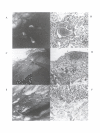Peritoneal inflammation - A microenvironment for Epithelial Ovarian Cancer (EOC)
- PMID: 15219235
- PMCID: PMC459521
- DOI: 10.1186/1479-5876-2-23
Peritoneal inflammation - A microenvironment for Epithelial Ovarian Cancer (EOC)
Abstract
Epithelial ovarian cancer (EOC) is a significant cause of cancer related morbidity and mortality in women. Preferential involvement of peritoneal structures contributes to the overall poor outcome in EOC patients. Advances in biotechnology, such as cDNA microarray, are a product of the Human Genome Project and are beginning to provide fresh opportunities to understand the biology of EOC. In particular, it is now possible to examine in depth, at the molecular level, the complex relationship between the tumor itself and its surrounding microenvironment.This review focuses on the anatomy, physiology, and current immunobiologic research of peritoneal structures, and addresses certain potentially useful animal models. Changes in both the inflammatory and non-inflammatory cell compartments, as well as alterations to the extracellular matrix, appear to be signal events that contribute to the remodeling effects of the peritoneal stroma and surface epithelial cells on tumor growth and spread. These alterations may involve a number of proteins, including cytokines, chemokines, growth factors, either membrane or non-membrane bound, and integrins. Interactions between these molecules and molecular structures within the extracellular matrix, such as collagens and the proteoglycans, may contribute to a peritoneal mesothelial surface and stromal environment that is conducive to tumor cell proliferation and invasion. These alterations need to be examined and defined as possible prosnosticators and as therapeutic or diagnostic targets.
Figures


References
-
- Tuhkanen H, Anttila M, Kosma V-M, Yla-Herttuala S, Heinonen S, Kuronen A, Juhola M, Tammi R, Tammi M, Mannermaa A. Genetic alterations in the peritumoral stromal cells of malignant and borderline epithelial ovarian tumors as indicated by allelic imbalance on chromosome 3P. Int J Cancer. 2004;109:247–252. doi: 10.1002/ijc.11733. - DOI - PubMed
LinkOut - more resources
Full Text Sources
Other Literature Sources

